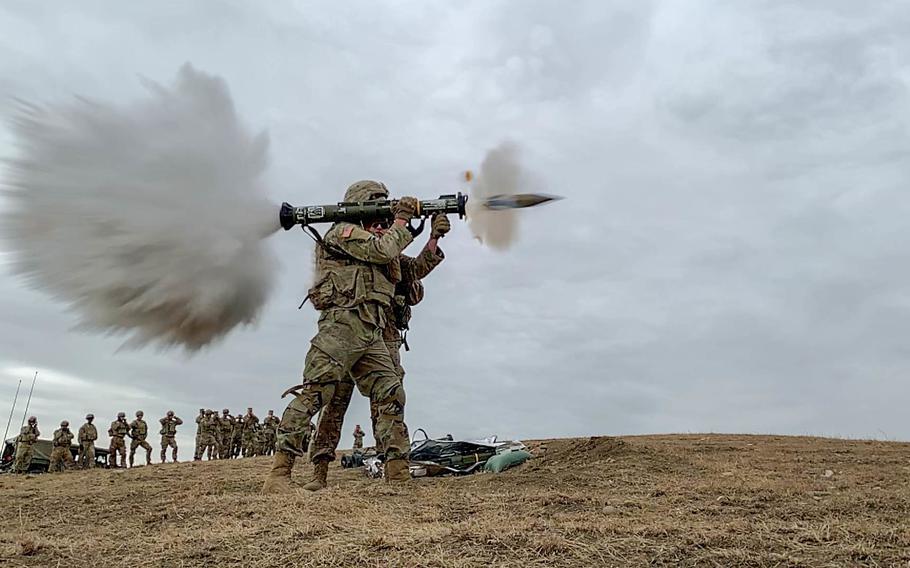
U.S. soldier from the 2nd Squadron of the 2nd Cavalry Regiment stationed in Vilseck, Germany, shoots an anti-armor AT4 weapon in August 2019 at the Vaziani Training Area, Georgia. (Ethan Valetski/U.S. Army video snapshot)
WASHINGTON — President Joe Biden has authorized a new $350 million round of military aid for Ukraine that includes fuel tankers, patrol boats and missiles as the country prepares for warmer weather and increased Russian attacks, the Pentagon announced Monday.
Since Russia’s war in Ukraine began more than a year ago, the United States has committed almost $33 billion in weapons, equipment and vehicles. The assistance has so far included at least one Patriot missile system, numerous Humvees, armored personnel carriers and drone systems.
This security package includes more ammunition for howitzers and rockets for the High Mobility Artillery Rocket Systems, or HIMARS, as well as shoulder-fired, anti-armor weapons, patrol boats and fuel tankers.
“To meet Ukraine’s evolving battlefield requirements, the United States will continue to work with its allies and partners to provide Ukraine with key capabilities,” the Pentagon said in a statement.
The new round of aid comes after Defense Secretary Lloyd Austin and Army Gen. Mark Milley, chairman of the Joint Chiefs of Staff, attended a meeting last week of the Ukraine Defense Contact Group — a collection of representatives from dozens of allied countries that meet to update Ukraine’s military situation and determine what it needs to fend off Russian forces. Meetings of the contact group often precede a new round of military aid.
“Above all, we're going to stay united,” Austin said last week after the meeting. “We're helping Ukraine fight to live free, and together we're helping to show that rules matter.”
Milley added: “This is and remains a Russian frontal assault on the rules-based international order that has been in place for 80 years, eight decades since the end of World War II. In the face of this act of aggression in a war of conquest, this group remains unified.”
The new military aid also comes as Russian and Ukrainian troops continue a bloody battle for Bakhmut — an area in eastern Ukraine that’s seen constant fighting for many weeks — and preparations are being made for an expected Russian offensive when the weather is warmer.
The new aid will go through the presidential drawdown authority, which takes the equipment directly from Pentagon stocks so it can be sent to Ukraine immediately. Other rounds of aid have been authorized via the Ukraine Security Assistance Initiative, which procures weapons and equipment from the defense industry and takes longer to reach Eastern Europe. For example, the U.S. has committed more than 30 M1 Abrams battle tanks through the initiative, and they’re not expected to reach Ukraine until late this year.
The aid announcement also came on the same day that Chinese President Xi Jinping arrived in Moscow to meet with Russian President Vladimir Putin. Previously, Beijing had said it was largely neutral about Russia’s invasion of Ukraine, but some observers contend Xi’s visit Monday indicates support for the fighting in Ukraine and limits international efforts to isolate Putin.
“It gives me great pleasure to once again set foot on the soil of Russia, our friendly neighbor, and pay a state visit to the Russian Federation at the invitation of President Vladimir Putin,” Xi said in a written statement after he arrived in Moscow for the three-day visit.
“Over the past 10 years, China and Russia have persisted in consolidating and developing bilateral relations on the basis of non-alignment, non-confrontation and non-targeting at any third party,” Xi added. “In the face of a turbulent and changing world, China is willing to continue to work with Russia to firmly uphold the international system.”
The Pentagon has cautioned China against sending any type of “lethal” aid to Russia to use in Ukraine and said Beijing would face consequences if it did so. A few weeks ago, U.S. officials said intelligence indicated China was considering helping Russia with military aid but added there was no evidence yet that it’s done so.
Xi’s visit with Putin comes at a time of frosty relations between their countries and the United States. China has been criticized for various military activities in the South China Sea and Taiwan Strait in recent years. Beijing caused alarm last month by floating a high-altitude surveillance balloon over the United States for several days before a U.S. fighter jet shot it down. Authorities are still going through the wreckage.
Two Russian fighter jets harassed a U.S. reconnaissance drone over the Black Sea last week. One of them eventually clipped the drone’s propeller and forced it to crash into the waters below. Moscow claims the drone was in restricted Russian airspace and basically caused itself to crash.
Though the U.S. has provided billions of dollars in military aid to Ukraine so far, it still has not agreed to requests from Ukraine for fighter jets. Biden and the Pentagon have said they don’t think the planes are needed there yet, mainly because Ukraine already has a fleet of its own fighter jets.
However, Slovakia and Poland last week became the first two nations to commit fighter aircraft to Ukraine when they pledged more than a dozen Russian-made MiG-29s — twin-engine fighters that entered service in the 1980s.
Poland bought a dozen MiG-29s from Moscow about 30 years ago. Slovakia retired its fleet last year, and will now pass them onto Ukraine.